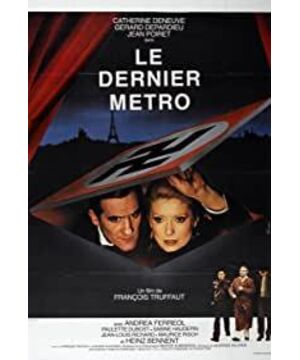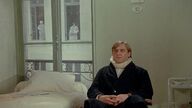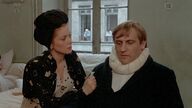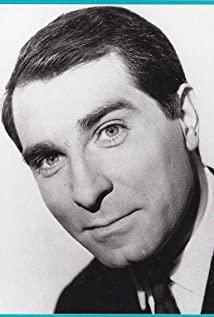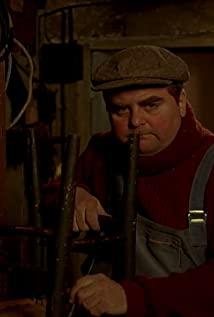"The Last Subway" is a "post-new wave" work. The film's director François Truffaut is a veteran of French "New Wave" films. At the end of the 1950s, he became famous at the Cannes Film Festival with his debut "Four Hundred Under" and created the history of "New Wave" movies. More than 20 years later, in 1980, Truffaut filmed "The Last Subway", which became the most eye-catching French film at the time. It not only achieved great commercial success, but also won the French film industry’s artistic creation. The lofty honor covered almost all the projects of the Caesar Prize that year. Such awards are rare in the film industry. The characteristics of Truffaut's works are delicate, calm and humane. Therefore, he is considered to be the best heir to the humanitarian tradition in French literature. "The Last Subway" can be said to be the inheritance and development of the author's style formed during the "New Wave" period. It is considered a work that combines tradition and innovation. Let's try to analyze this work from two aspects: inheritance and development, tradition and innovation.
1. The combination of prose style and drama.
Prose style is a very basic feature of French "New Wave" movies, and it is also an obvious difference between French movies and Hollywood movies. This style of prose can be summed up with the words "San" and "Ya". The film structure is loose, the plot is watered down, the drama is not strong, and the narrative does not form a tightly linked plot chain. The taste of the film is mainly embedded in the delicate and true details and its lyrical style. It has a profound charm, like a green fruit or a pot of daffodils: elegant, delicate and remote. This is true of "Four Hundred Under", and so is "The Last Subway". Although the background of the film is the Second World War, it does not show major events and heroic behaviors, but depicts the daily life of the theater during the occupation period. The interest lies in the details, which seems to be the world observed by children. This is exactly the inheritance of the "new wave" style. But it has developed again, that is, the drama of the film has been enhanced, and the drama has penetrated into the style of prose culture.
The film uses the first few scenes to gradually bring the audience into a specific era environment. The young actor Bernard applied to the Montmartre Theatre. Marion, the theater manager, is dealing with various daily affairs. Through her dialogue with some people, the audience knew that the former theater manager Lucas "has gone to South America" and is now represented by his wife Marion. But then a cellar appeared in the film, and a character hidden in the cellar appeared. The director used a close-up of a face to push this character to the audience, giving the audience a suspense: Who is this? Then, the plot unfolded slowly, making the audience understand that Lukas did not leave Paris, but was hiding in the cellar of the theater.
Although the theme of "The Last Subway" is not about love, the director intersperses and interweaves the subtle and unpredictable love into the plot. When the secret police came to search the theater and declared that they would search the cellar, the atmosphere was very tense. "Will Lucas be discovered?" also became a suspense. In the end, Lucas finally escaped the storm. However, the plot unfolds again: Bernard meets Lucas in the cellar, and the meeting between the two is meaningful. The audience must wonder: What happens when a husband and a wife love each other? Will glaring at me? Or is it a big fight? The director treated this as a calm conversation. Lucas asked: "Marion fell in love with you, how about you?" As an answer to this question, it was the following scene: Bernard was leaving the theater to participate in the resistance movement. In this scene, Marion and Bernard had a very wonderful conversation, which shows that they have a certain distance in political thoughts, but they are also attractive to each other. This relationship of love and repulsion is very real, and it also enhances the dramatic effect of the film. Therefore, as a "post-new wave" work, "The Last Subway" not only inherits the prose style of the New Wave, but also strengthens its dramatic plot, giving the film the characteristics of both elegance and popular appreciation.
2. The details are true and the production is exquisite.
Another characteristic of "New Wave" movies is simplicity, truthfulness, naturalness, and smoothness. This is also the style of Truffaut. "The Last Subway" also inherited and carried forward this point. There are many plot descriptions in the film that have historical basis. The author weaves many events that occurred in the theater industry into the plot of the film. For example, the episode in which Daxia, the drama critic of "I'm Everywhere" was beaten in the film, is from the historical facts of the famous actor Jean Marais beating the drama critic Lobreu of "I'm Everywhere" in public in 1941. The name Daxia is precisely Lobru's pen name. In addition, the uncle of director Truffau was also taken to a concentration camp by fascists. When he was arrested, in order to avoid the misfortune of other comrades, he silently signaled to the comrades not to recognize him. These scenes are all blended into the film.
There are also some detailed descriptions in the film, either to explain the plot or to set off the atmosphere of the times. Mary bought seven kilograms of black market ham. How could she stand it alone? But to enjoy it with a man hiding in the cellar is a reasonable need; a few actresses chat together and show off the stockings on their legs. It turns out that these are not real stockings, but some kind of paint applied to the legs. ; The yellow stars on the breast of the little Jewish girl...These are the unique scenes of that era.
The "New Wave" films of that year were accused of being "roughly produced." More than 20 years later, we saw that the director who was fledgling at the beginning of the year has now grown into a skilled master. Truffaut's artistic treatment in "The Last Subway" reached a very high level. In order to enhance the atmosphere of the times, the color of the film is not gorgeous, but a dark tone similar to black and white. It gives people a feeling of old times, reminding people of the past dark night and foggy era, with dim lights and dark shadows.
The setting of the film is full of texture, making the audience feel as if they are in the backstage of the theater, can touch a setting, breathe the dust in the backstage, and feel the humid and cold atmosphere.
3. Combine documentary and fiction.
In order to enhance the realism of the film, the director used a combination of documentary and fiction. After the winter of 1942, from Bernard's departure from the theater to the victory of the Anti-Fascist War in 1945, a series of historical events took place, and the fate of the characters in the film also changed accordingly. When the director handled this process, he incorporated documentary techniques and used a lot of documentary footage with narration as a testimony of historical changes. This kind of treatment has not been used during the "new wave" period. It is a new development. This combination of fiction and documentary has produced a confusing and difficult to distinguish effect. For example, when liberation was approaching, street fighting broke out in Paris. Both Lucas and Bernard participated in the battle. After the battle, we saw Marion walk into a hospital ward to visit Bernard, who was injured in bed, and talked about the love that was deep in our hearts. The audience thought this was the continuation of the story between the two of them, but the big screen suddenly appeared on the stage, quickly pulled from left to right, closed, and occupied the entire screen. The audience suddenly realized that this was a play in a play. They continued acting again. The life stage and the theater stage merge into one. When Marion, Bernard and Lucas called the audience together, the footlights of the stage and the lights of the screen were also integrated. The audience seems to be in the theater, so that the movie audience has the feeling of watching a movie and a theater performance. This is the ingenuity of the director's technique.
The director Truffaut is a film writer full of childlike innocence. Although his own childhood was unfortunate, he did not have the warmth of the family, like a street child. These conditions are reflected in his debut work "Four Hundred Under". But the misfortune of his childhood did not extinguish his innocence and cynicism. On the contrary, it made him feel that this world needs "love". His works always show a heart of love, which is very valuable. The childishness in some of his works often makes people laugh. For example, the boy's "love" for a classmate's mother in "Pocket Money". "The Last Subway" has a child-like vision, but also because what he showed happened to be his childhood memories. Some critics criticized him for behaving too well in the "Occupation Period." Indeed, the tone of the film is not harsh, without cruel scenes, but a tragicomedy style. Comedy resides in the background of tragedy and achieves a clever balance. Happiness and pain, challenge and betrayal, and the distress of love... are intertwined, making people cry but smiling.
The heroes and heroines of the film are two shining red stars in the French film industry. Catalina Deneuve, who plays Marion, is known as "Woman's 40 A Flower." She has become popular since she filmed "The Umbrella of Cherbourg" in 1963. For 20 years, she has always maintained her star status. With her age and acting skills, she has successfully played Marion, a mature woman who is in a difficult situation and has a complicated heart. Geral Depardieu, who plays Bernard, is an actor who has made great achievements in the past 10 years. He has strong plasticity and various talents. The critics in the United States and the Soviet Union praised him very much, saying that he "set off a new wave by himself" and is currently the most popular male star in the French film industry. The character of Bernard he created is full of vigor, strength and texture, which makes people feel authentic and credible.
The success of the film is multifaceted, and this is also due to the director's ability to organize and unite his creative team.
Truffaut died on October 21, 1984. Before his death, I also filmed "The Woman Next Door" (1981) and "Come on Sunday!" "(1983) Two films, but neither of them has as much influence as "The Last Subway". Therefore, it can be said that "The Last Subway" was his masterpiece before his death. It not only occupies an important position in all his own creation chronology, but also left a page in the history of film that cannot be ignored. It is not unreasonable that French film critics rated "The Last Subway" as "the best film of the 80s in France" in 1990.
View more about The Last Metro reviews


